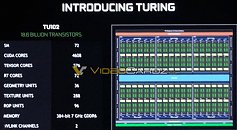Thursday, August 23rd 2018

NVIDIA "TU102" RT Core and Tensor Core Counts Revealed
The GeForce RTX 2080 Ti is indeed based on an ASIC codenamed "TU102." NVIDIA was referring to this 775 mm² chip when talking about the 18.5 billion-transistor count in its keynote. The company also provided a breakdown of its various "cores," and a block-diagram. The GPU is still laid out like its predecessors, but each of the 72 streaming multiprocessors (SMs) packs RT cores and Tensor cores in addition to CUDA cores.
The TU102 features six GPCs (graphics processing clusters), which each pack 12 SMs. Each SM packs 64 CUDA cores, 8 Tensor cores, and 1 RT core. Each GPC packs six geometry units. The GPU also packs 288 TMUs and 96 ROPs. The TU102 supports a 384-bit wide GDDR6 memory bus, supporting 14 Gbps memory. There are also two NVLink channels, which NVIDIA plans to later launch as its next-generation multi-GPU technology.
Source:
VideoCardz
The TU102 features six GPCs (graphics processing clusters), which each pack 12 SMs. Each SM packs 64 CUDA cores, 8 Tensor cores, and 1 RT core. Each GPC packs six geometry units. The GPU also packs 288 TMUs and 96 ROPs. The TU102 supports a 384-bit wide GDDR6 memory bus, supporting 14 Gbps memory. There are also two NVLink channels, which NVIDIA plans to later launch as its next-generation multi-GPU technology.

65 Comments on NVIDIA "TU102" RT Core and Tensor Core Counts Revealed
Comparing clocks and CUDA core count is useless when you know nothing about their performance.
Even if we're pessimistic, and Nvidia delivers a conservative 30% over the previous generation, that's still a significant upgrade. AMD could only dream of such improvements. Most people don't buy a new card every generation.
with there I740 sometime back in 98 96?
Craped on about it for ages then when it came out it sucked.
Also is the real time ray tracing some proprietary tech? If so.... hmm could be intresting if AMD plays catch up after all the Next gen console might has it...
or is this like physis it was pretty lame and about as exciting as a paper clip.
Right now very few games adopting
DX12
Microsoft just introduced DXR this year for Windows Insiders RS4 update. DXR SDK is still experimental. DXR for consumers is expected in the Windows 10 Autumn update
DX12+DXR
Nvidia introduced their RTX solution (Hardware+Software) for ray tracing
DX12+DXR+Nvidia RTX
It's still not confirmed if Turing will do Rapid Packed Math. If it does, that would explain the boost in Wolfenstein.
I'm a bit more conservative with that. But the specs really aren't that theoretical and if you or anyone else really thinks its plausible for Nvidia to massively increase IPC without speaking highly of it in the keynote (which they haven't, it was RTX and DLSS front to back), well... its silly.
What we have is very very clear:
- overinflated and misleading Nvidia keynote statements on perf increases, placing Pascal next to Turing in tasks Pascal was never designed for
- higher TDP to cater for additional resources on die - RT and tensor cores
- A marginally smaller node 16>12nm
- Subtle changes to the shaders themselves
- Lower baseclocks and boosts
- Only slightly higher shader counts
There is just no way this is going to massively outperform Pascal per shader. If you then factor in the price and shader counts, its easy to come to conservative numbers. And its wishful thinking to see 50% perf increases - except if all you look at is the 2080ti and place it next to a 1080 non ti. But you can buy two 1080's at that price ;)You're not the only one. But the real question should be: what's the point of such a big die just to cater for some extra fancy effects that are completely detrimental to overall performance for its primary use case... The hands on with a 2080ti is telling: minor effects cause massive performance hits. Nvidia can only do this because they own the market; so that brings us back to the no-AMD-competition statement but in a different way :)
Another massive hurdle is in fact AMD's dominance of the console space; when it comes to gaming, AMD really has more control of the market than Nvidia because Nv only hits the niche of high end PC gaming with RTX. That's not a big market and it means Nv has to pony up lots of money to get their tech adopted. There is no ecosystem for it. If you look at (semi) pro then its a different story: the Quadros I do understand, for non-realtime production work, RT is a step forward.
There has always been good reason in gaming to pre-cook and design everything and make it efficient. The only trade off is labor, and the more work you put in, the better it can perform. It can even be made dynamic for a long stretch with our current technology. RT is grossly inefficient in comparison and it only really shines if it's there without you really 'noticing' it. If you have to look for your RT effects, its just a gimmick. An expensive one.
But yeah these Turings are very big chips, heck tu104 is much bigger than gp102. Maybe Turing was meant to be 7nm gpu in the first place and Volta without RT or tensors battling with high end 2018 radeons(like gv102 with ~4608cc and ~600mm² and gv104 with ~3072cc and ~400mm²). But without competition Nvidia went for Turing at 12nm and canned "little" Voltas. One thing is missing though, fp64 Turing I doubt with all those different cores turing has full fp64 compute.
But anyhow that shader mambojambo reminded me about those advanced shadings on Turing. To my surprise nvidia removed things on their developer RTX platfrom site. There were four methods under Rasterization in the morning: Mesh shading, Variable Rate Shading, Texture base shading and Multi-view Rendering. Mesh shading is removed completely and all the details have removed. However they are still on the html code:
People need to stop guessing Turing's performance based on Pascal figures.
I see the embargo date on these, is this also the review embargo?
The low hanging fruit is gone by now for CUDA. You can refer to Intel Core for an indicator of how IPC can grow.
they are,as all remembe release 3 times old gpu with old tech but new names. vega different version..
and looks amd release 4th of vega gpu,but it has build 7nm line... huh! its hould banned.
so forget nvidia 'milkins'..
nvidia this release is brand new turing and has as always again brand new gpu with new graphics option and and new connectors and it is 40-50% faster than old pascal.
little respect, if nvidia stop release gpus for desktop users we all must uselausy junk amd terrible power eat junkies, bcoz truth is that if we look vega power eats its slow gpu.
nvidia gtx 1000 series is much better choice.
last.
nvidia is factory and its build great gpus abut not doing it fun,its want property lke all business.
nvidia moust common csh coming indestry,more than 3/4 coming there so respect.
planning,building,testing cost alot cash billions!
so new gpus cost little more than amds junk,but when u buy nvidia gpu,you get high qualitymfast,excellent efficiency latest tech gpu.
its cost many,but when you buy nvidia gpu,you can trust you get next time same excellent gpu again,next is 2019.
p.s. im not nvidia worker or so, i just see things what they are, i use bfore amd product cpu and gpu..not evermore again. i think amd cheat clear customer... i remembe again that terrible hypeting and commercial from vega gpu...
and what you get, old lausy tech slow junk,overpriced gpu with 500W power eat. phyi!